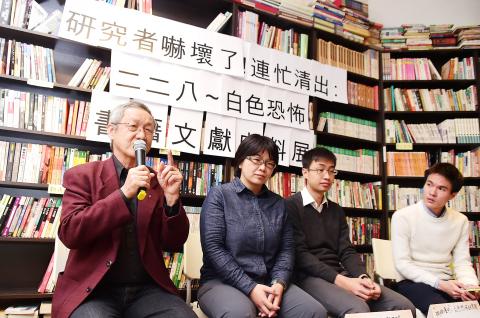The Libratory, an independent vintage bookstore near Taipei’s National Taiwan Normal University, yesterday launched a small exhibition of historical materials concerning the 228 Massacre and the White Terror era, provided by researchers, in defiance of the recent warrantless search by the military police of a civilian’s residence for such material.
The exhibition is titled Researchers are so frightened that they have rushed to clear their storage of 228 and White Terror-related books and documents. The organizers said they are not only criticizing the military police, but also those who have praised an antique collector and dealer surnamed Hu (胡) — who says he has a collection of more than 1,000 White Terror-era documents — as a protector of historical documents.
They are also taking aim at those who say that Democratic Progressive Party politician and TV show host Peng Wen-cheng (彭文正) — or other politicians — can be trusted with the documents.

Photo: Hu Shun-hsiang, Taipei Times
The bookstore invited several academics to the launch of the exhibition yesterday to share their views on the preservation of Taiwan’s political documents.
Former 228 Memorial Museum director Iap Phok-bun (葉博文) said many people called the Chinese Nationalist Party (KMT) regime a “settler regime,” but he thought a more accurate description based on its deeds would be “wanted-criminal regime.”
“When wanted criminals are on the lam and randomly go into your house, they tie you up and threaten you; inside, they fear defectors and outside, they face arrest,” Iap said, explaining why the KMT had feared the unsealing of the documents.
The other two young academics invited to the event addressed widespread misgivings among Internet users about the government’s trustworthiness to handle the documents and criticized the praise lavished on Hu.
Hu has become a much-sought-after guest on various political TV shows. His appearances on TV culminated on Thursday night when he handed over a cardboard box of documents to Peng and several other Democratic Progressive Party politicians for them to temporarily look after, as Hu claimed he could not sleep under the stress of possessing them.
The handover received the acclaim of many viewers who said that the government cannot be trusted with the files, but it has also raised the hackles of many White Terror era researchers who accused Hu of self-promotion and called for professional conservation of the documents.
Taiwan Association for Truth and Reconciliation former executive secretary Yeh Hung-ling (葉虹靈) called on those who now have the documents to immediately donate them to the National Archives Administration.
“Don’t turn this farce into a tragedy,” she said. “Three unprofessional people perusing the documents might result in them being damaged. Handling historical documents requires professional skills.”
Of Internet users’ concerns the files might be “deliberately destroyed” by the current administration, Yeh said that would be “almost, or I should say absolutely, impossible.”
She railed against Hu and political commentators for fanning conspiracy theories and discrediting academics working on the issue.
White Terror researcher Lin Yi-hsuan (林邑軒) said the public has so far been unfamiliar with the historical materials and now is a good time for them to be brought to light.
“Let the collection of documents be institutionalized,” he said.

A strong continental cold air mass is to bring pollutants to Taiwan from tomorrow, the Ministry of Environment said today, as it issued an “orange” air quality alert for most of the country. All of Taiwan except for Hualien and Taitung counties is to be under an “orange” air quality alert tomorrow, indicating air quality that is unhealthy for sensitive groups. In China, areas from Shandong to Shanghai have been enveloped in haze since Saturday, the ministry said in a news release. Yesterday, hourly concentrations of PM2.5 in these areas ranged from 65 to 160 micrograms per cubic meter (mg/m³), and pollutants were

Taiwan’s armed forces have established response protocols for a wide range of sudden contingencies, including the “Wan Chun Plan” to protect the head of state, the Ministry of Defense (MND) said today. After US President Donald Trump on Saturday launched a series of airstrikes in Venezuela and kidnapped Venezuelan President Nicolas Maduro, concerns have been raised as to whether China would launch a similar “decapitation strike” on Taiwan. The armed forces regularly coordinate with relevant agencies and practice drills to ensure preparedness for a wide range of scenarios, Vice Minister of National Defense Hsu Szu-chien (徐斯儉) told reporters before a

EVA Airways on Saturday said that it had suspended a pilot and opened an investigation after he allegedly lost his temper and punched the first officer several times as their plane was taxiing before takeoff at Los Angeles International Airport. According to a report published on Thursday by The Reporter, the incident occurred after the flight’s Malaysian first officer tried to warn the Taiwanese pilot, surnamed Wen (文), that he was taxiing faster than the speed limit of 30 knots (55.6kph). After alerting the pilot several times without response, the first officer manually applied the brakes in accordance with standard operating

NOT AN OPENING: Trump’s violation of international law does not affect China’s consideration in attacking Taiwan; Beijing lacks capability, not precedent, an official said Taiwanese officials see the US’ capture of the president of Venezuela as a powerful deterrent to Beijing’s aggression and a timely reminder of the US’ ability to defeat militaries equipped with Chinese-made weapons. The strikes that toppled Venezuelan President Nicolas Maduro signaled to authoritarian leaders, including Chinese President Xi Jinping (習近平), US President Donald Trump’s willingness to use military might for international affairs core to US interests, one senior official in Taipei’s security circle said. That reassured Taiwan, the person said. Taipei has also dismissed the idea that Trump’s apparent violation of international law could embolden Beijing, said the official, who was not